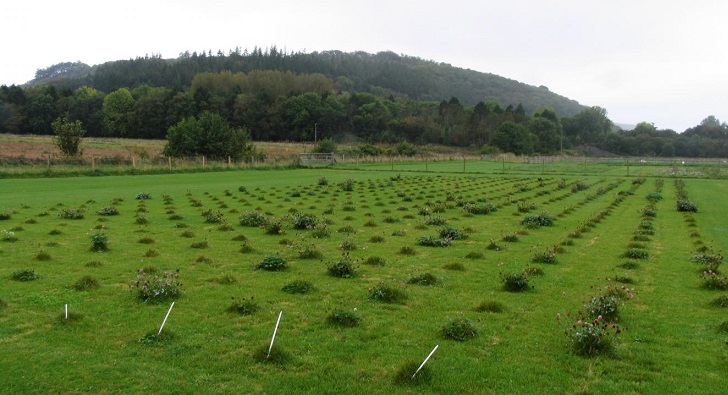Red clover genome to help restore sustainable farming
Six red clover varieties with diverse architectures and traits have recently been selected as parents of the next year generation.
The Genome Analysis Centre (TGAC) in collaboration with IBERS, has sequenced and assembled the DNA of red clover to help breeders improve the beneficial traits of this important forage crop. The genome is published in Scientific Reports, a journal from the Nature publishing group.
Before industrial nitrogen fertiliser production (from fossil fuels), red clover and other legume crops were essential in crop rotation, improving soil fertility. Legumes boost soil nitrate fertility by assimilating nitrogen from the air, recruiting soil bacteria to help - this is considerably more eco-friendly than the equivalent industrial process.
Indeed, environmental concerns and climate change mitigation is putting red clover back in the spotlight. This requires genetic improvements to help boost its performance.
Red clover's chief benefits (alongside soil improvement) is to provide a protein-rich livestock feed - it also boosts omega-3 fatty acids in ruminant milk. Compared to white clover and other legumes, red clover has high levels of an enzyme that causes its' protein to be digested more slowly and effectively - it's more nutritious per mouthful.
However, currently, red clover only grows well for two or three seasons and it does not recover well from grazing by livestock. It also does not lend itself easily to traditional crop breeding practices, with severe loss of vigour and fertility if inbred. An ongoing project at TGAC and IBERS aims to use a collection of diverse natural lines of red clover for breeding new elite varieties more tolerant to grazing, thus making it more persistent, and to understand the domestication process that led to the adoption of red clover as a crop.
For the breeders, this draft genome provides a welcome tool, with which to speed up incorporation of traits that are beneficial for the clovers' use in sustainable agriculture from natural populations of red clover plants sampled from all over Europe. Widening of the genetic diversity of the breeding populations will help to make red clover a more robust and reliable crop.
Therefore, the genome sequence promises to be a valuable platform for advances in studies of traits of biological and agronomic importance in forage crops.
Lead author Jose de Vega, Researcher at TGAC, said: "The publication of the red clover reference genome is an important milestone, as it represents the first genome sequence of the clover forage crops, which are key components of more sustainable livestock agriculture.
"The availability of the genome assembly will pave the way towards genomics-assisted breeding methods for forage legumes, and provide a platform for deeper understanding of the genetics of forage crop domestication."
"Red clover is attractive because of its high protein content, diversity and ability to fix atmospheric nitrogen, but to enhance its role in sustainable agriculture requires improvements of persistency, disease resistance, and tolerance to grazing."
Senior author and project leader Leif Skøt from the Institute of Biological, Environmental and Rural Sciences (IBERS) at Aberystwyth University said: "The red clover genome puts us in a great position to incorporate and build on this resource. We work closely with Dr David Lloyd, IBERS forage legume breeder, so we are using our genomic tools to assist in improving the precision and speed of breeding better red clover varieties. This is very timely as the importance of legumes in sustainable agriculture is "rediscovered".
"The collaboration between TGAC and IBERS reinforces the UK's leadership in translating the development of genetic and genomic resources from fundamental science to applications with a potential impact on the local and national economy".
The development of a more sustainable agriculture is a key aspect of the UK research strategy, positioning both Institute's as international leaders in biotechnology specifically in the area of forage legumes. This is delivering impact to a broad range of stakeholders and ensuring that the genomics resources will be translated to research and breeding programmes.
The study entitled: "Red clover (Trifolium pratense L.) draft genome provides a platform for trait improvement" is published in Scientific Reports, a journal of the Nature publishing group.
This work results from the partnership between, TGAC, IBERS and Germinal Holdings LTD, part funded by the latter through TGAC Capacity and Capability Challenge (CCC) programme, and a Responsive Mode award from the BBSRC.
IBERS and TGAC are strategically funded by BBSRC and TGAC operates a National Capability to promote the application of genomics and bioinformatics to advance bioscience research and innovation.
Source: The Genome Analysis Centre
BİOLOGY NEWS
-
RNA from Trained Aplysia Can Induce an Epigenetic Engram for Long-Term Sensitization in Untrained Aplysia.
-
HOW WE BECOME HAPPY
-
More tomatoes, faster: Accelerating tomato engineering
-
Purest yet liver-like cells generated from induced pluripotent stem cells
-
Legions of nanorobots target cancerous tumors with precision
-
CRISPR gene editing reveals new therapeutic approach for blood disorders
-
Quantum dots with impermeable shell: A powerful tool for nanoengineering
-
Thousands on one chip: New method to study proteins
-
Gene Drive Technology: Where is the future?
-
Four newly identified genes could improve rice
-
Watching the luminescent gene switch
-
DNA damage by ultrashort pulses of intense laser light
-
Mantis shrimp inspires next generation of ultra-strong materials
-
Specialized life forms abound at Arctic methane seeps
-
Ocean warming and acidification impact on calcareous phytoplankton



